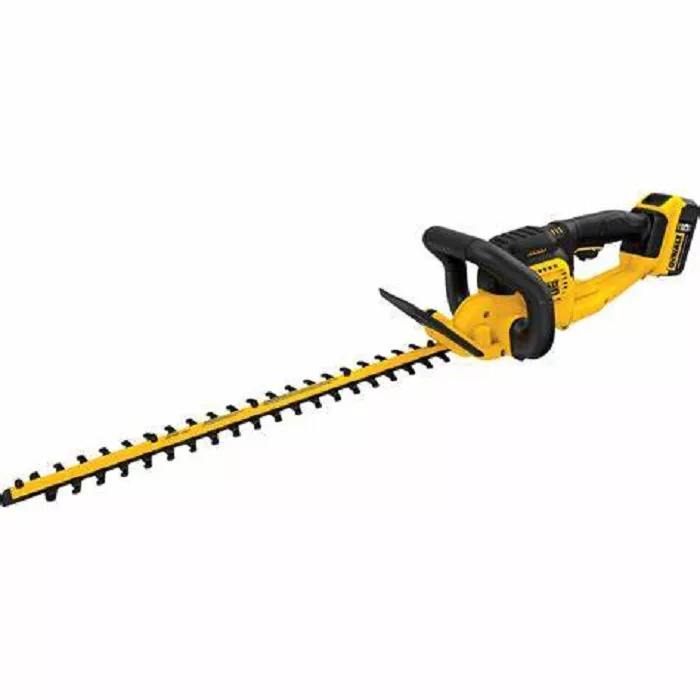A cordless hedge trimmer is a powerful and convenient tool designed for trimming and shaping hedges, shrubs, and bushes. Powered by rechargeable batteries, it offers the freedom of movement without the limitations of cords. This guide explores the advantages and disadvantages of using a cordless hedge trimmer, provides detailed instructions on how to use it, and highlights ideal scenarios for its application.
Advantages of the Cordless Hedge Trimmer
1. Cordless Freedom
Cordless hedge trimmers eliminate the hassle of managing power cords, allowing you to move freely and work on hedges in any location.
2. Lightweight and Easy to Handle
Most models are designed to be lightweight, making them comfortable to use for extended periods without causing strain.
3. Quiet Operation
Cordless trimmers are generally quieter than gas-powered alternatives, reducing noise pollution and making them suitable for residential areas.
4. Eco-Friendly
With no emissions during operation, cordless hedge trimmers are an environmentally conscious choice.
5. Low Maintenance
Unlike gas-powered models, there are no fuel, oil, or complex components to maintain. Basic cleaning and battery care are sufficient.
6. Variable Blade Lengths
Cordless trimmers come with various blade lengths, providing options for precise trimming and shaping tasks.
Disadvantages of the Cordless Hedge Trimmer
1. Limited Battery Life
Battery operation restricts runtime, which may require recharging or swapping batteries during larger projects.
2. Reduced Power
While sufficient for most residential tasks, cordless models may lack the cutting power required for thick branches or dense hedges.
3. Initial Cost
High-quality cordless hedge trimmers and their batteries can be more expensive upfront than corded or gas-powered models.
4. Battery Degradation
Over time, battery efficiency decreases, which may lead to shorter runtimes and the need for replacements.
How to Use the Cordless Hedge Trimmer
Step 1: Charge the Battery
- Fully charge the battery using the supplied charger before use.
- Follow the manufacturer’s guidelines to ensure proper charging and battery health.
Step 2: Inspect the Trimmer
- Check for any visible damage to the trimmer, blades, or battery compartment.
- Ensure the blades are sharp and free of debris.
Step 3: Prepare the Area
- Remove obstacles like rocks, branches, or garden tools from the work area.
- Inform others to maintain a safe distance while you work.
Step 4: Assemble and Attach the Battery
- Insert the fully charged battery into the designated compartment until it clicks securely.
- Confirm that all parts, including the blade guard, are properly assembled.
Step 5: Start the Trimmer
- Turn on the trimmer by pressing the power button or trigger.
- Adjust the blade speed or settings if your model offers variable options.
Step 6: Trim Hedges and Shrubs
- Hold the trimmer at a comfortable angle, aligning the blades with the area to be trimmed.
- Use smooth, sweeping motions for even cuts and avoid forcing the trimmer through thick branches.
Step 7: Turn Off and Clean
- Turn off the trimmer and remove the battery before cleaning or storage.
- Wipe down the blades and housing to remove sap and debris.
Step 8: Store Properly
- Store the trimmer and battery in a cool, dry place away from moisture and extreme temperatures.
- Use a protective cover to prevent dust accumulation and accidental damage.
Usage Scenarios
Residential Gardens
Cordless hedge trimmers are ideal for trimming and shaping hedges, bushes, and shrubs in small to medium-sized residential gardens.
Tight Spaces
Their lightweight and cordless design make them perfect for navigating tight spaces or intricate trimming tasks.
Noise-Sensitive Areas
Thanks to their quiet operation, they can be used in noise-sensitive neighborhoods or during early morning hours.
Regular Maintenance
Use cordless hedge trimmers for regular maintenance to keep your garden neat and tidy without the hassle of cords or fuel.
Seasonal Pruning
They are effective for seasonal pruning tasks, ensuring plants remain healthy and well-shaped throughout the year.
Maintenance Tips
1. Blade Care
- Clean the blades after each use to remove sap and debris.
- Sharpen the blades periodically to maintain cutting efficiency.
2. Battery Maintenance
- Recharge the battery promptly after use.
- Avoid leaving the battery in extreme heat or cold to prevent degradation.
3. Periodic Inspection
- Inspect the trimmer for wear and tear, including loose screws or damaged components.
- Replace any worn parts to ensure safe operation.
4. Storage
- Store the trimmer and battery in a protective case or on a tool rack.
- Keep the storage area clean and dry to prevent rust and damage.
Conclusion
The cordless hedge trimmer is a versatile and convenient tool for maintaining a well-groomed garden. Its cordless design, lightweight construction, and eco-friendly operation make it an excellent choice for homeowners. By following this guide, you can use your cordless hedge trimmer safely and effectively, ensuring optimal performance and a beautiful outdoor space. Whether for routine maintenance or intricate shaping tasks, the cordless hedge trimmer is a reliable addition to your gardening toolkit.
Related Topics:
- COMPACT TABLE SAW: A COMPREHENSIVE REVIEW
- LASER LEVELER: COMPREHENSIVE EVALUATION
- LASER LEVELER: COMPREHENSIVE EVALUATION

